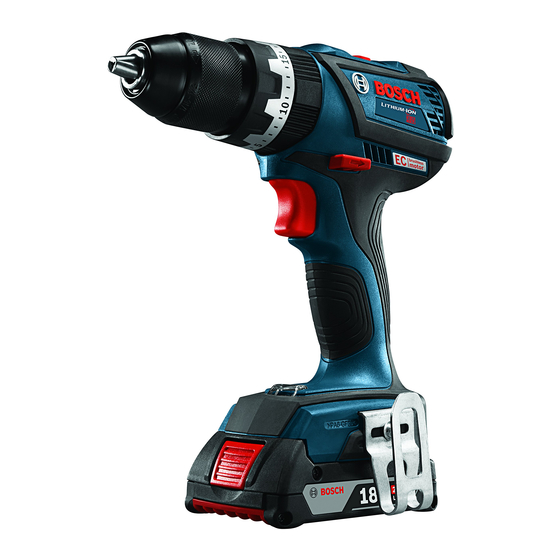Bosch DDS183B Manual de instruções de funcionamento/segurança - Página 13
Procurar online ou descarregar pdf Manual de instruções de funcionamento/segurança para Perfurar Bosch DDS183B. Bosch DDS183B 45 páginas.

BM 2610042664 DDS183 HDS183.qxp_HDS 1/4/16 1:11 PM Page 13
DRILL BITS
Always inspect drill bits for excessive wear. Use
only bits that are sharp and in good condition.
TWIST BITS: Available with straight and
reduced shanks for wood and light duty metal
drilling. High speed bits cut faster and last
longer on hard ma terials.
CARBIDE TIPPED BITS: Used for drilling
stone, con crete, plaster, cement and other
unusually hard nonmetals. Use continuous
heavy feed pres sure when employing carbide
tip bits.
DRILLING WOOD
Be certain workpiece is clamped or anchored
firm ly. Always apply pressure in a straight line
with the drill bit. Maintain enough pressure to
keep the drill "biting".
When drilling holes in wood, twist bits can be
used. Twist bits may overheat unless pulled out
frequently to clear chips from flutes.
Use a "back-up" block of wood for work that is
likely to splinter, such as thin materials.
its maximum safe operating speed is not
exceeded by the nameplate speed of the
tool. Do not exceed the recommended wheel
diameter.
SANDING AND POLISHING
Fine sanding and polishing re quire "touch".
Select the most efficient speed.
When using polishing bonnets, alway be sure
the excess string that secures the bonnet is
tucked well within the bonnet during operation.
WIRE BRUSHES
Work with brushes requires high speeds.
BRUSHING PRESSURE
1. Let the tips of a wire brush do the work.
Operate the brush with the lightest pressure
so only the tips of the wire come in contact
with the work.
2. If heavier pressures are used, the wires
will be overstressed, resulting in a wiping
action; and if this is continued, the life of the
brush will be shortened due to wire fatigue.
3. Apply the brush to the work in such a way
that as much of the brush face as possible is
in full contact with the work. Applying the
side or edge of the brush to the work will
result in wire breakage and shortened brush
life.
DREMEL • 2610042664 01• K/K • 5.50" X 8.50" (AMAC)
Before
using
accessory, be certain that
You will drill a cleaner hole if you ease up on
the pressure just before the bit breaks through
the wood. Then complete the hole from the
back side.
DRILLING METAL
There are two rules for drilling hard materials.
First, the harder the material, the greater the
pres sure you need to apply to the tool. Second,
the harder the material, the slower the speed.
Here are a couple of tips for drilling in metal.
Lubri cate the tip of the bit occasionally with
cutting oil except when drilling soft metals such
as alu minum, cop per or cast iron. If the hole to
be drilled is fairly large, drill a smaller hole first,
then enlarge to the required size, it's often
faster in the long run. Main tain enough
pressure to assure that the bit does not just
spin in the hole. This will dull the bit and greatly
shorten its life.
DRILLING MASONRY
Soft materials such as brick are relatively easy
to drill. Concrete however, will require much
more pressure to keep the bit from spinning. Be
sure to use carbide tip bits for all masonry work.
an
CORRECT: Wire tips doing the work.
INCORRECT: Excessive pressure can cause wire breakage.
-13-
